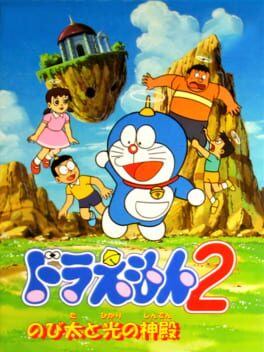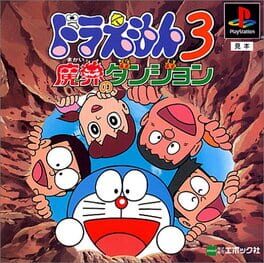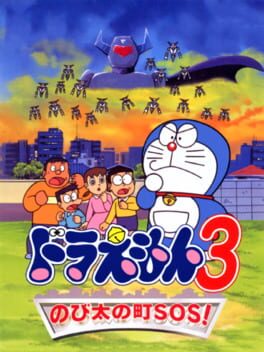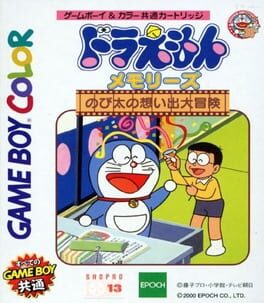

Doraemon 2: Nobita to Hikari no Shinden (Doraemon 2: Nobita and the Temple of Light) is an action game for the Nintendo 64. It was released only in Japan in 1998 . The game is based on the Japanese manga Doraemon and is the second in the Nintendo 64 series, it was preceded by Doraemon: Nobita to Mittsu no Seirei Ishi and followed by Doraemon 3: Nobi Dai no Machi SOS!, all only released in Japan.
Also in series
Reviews View More
With the title translating to "Nobita and the Temple of Light", this is the second in the Doraemon N64 trilogy, and after enjoying the first game so much, I rushed out to procure the other two games to see how they stacked up. Much to my surprise, this is actually quite the genre change compared to the first game, and also doesn't connect to the first in any way narratively despite the "2" present in the title XD. I guess this one just happens to be based off of somewhere different in the manga. It took me around 7 or so hours to beat the game getting all but a handful of the collectibles.
The story here is similarly overly verbose like the first game's is, but it's an entirely new story about Doraemon, Nobita, and their friends. While traveling home on their time machine from an adventure, Nobita pulls out the shiny crystal he nabbed during their trip. However, the crystal suddenly goes off in an explosion of light that swallows the whole gang, dropping them in an unfamiliar location. Nobita finds himself alone in a strange fantasy land, and after finding his friends (which doesn't take toooo long), he learns that the whole reason this land is in peril is because of the gem he stole. He and his friends need to recover the other power crystals and restore the titular Temple of Light to an equilibrium to save the world~. The story is predictably nothing stellar (this is just a kids game, after all), and it's packed with fairly uninteresting dialogue among the many NPCs you meet. And there are a lot of NPCs in this game, because this is an adventure game!
Where the first Doraemon 64 game plays more like a simplified Banjo-Kazooie, this game takes a big genre leap in that it plays far more like a simplified 3D Zelda with some platforming thrown in. However, it's far from a typical action/adventure game. You can change characters during specific plot points, but I don't think you can change them at will? At least I never found out how, although they all seemed to play more similarly than they did in the first game. You have an overworld composed of many areas with three dungeons to find those special gems in, but there's only combat in those dungeons. The overworld is entirely for solving puzzles (both environmental and NPC-related) and some simple platforming, and you can't even use weapons in it. The camera angle in the overworld is a pretty zoomed out isometric view, compared to the behind-the-shoulder closer angle in the dungeons, so combat would be pretty weird there, but it's still an odd way to put the game together.
The adventure aspect of the game is overall pretty weak, sadly. A lot of the running around is mostly back tracking and just hunting for one of Doraemon's (once again lost) tools to use in the place you happen to need to use it, or going to do something for an NPC yet again (the lead-up to the 2nd dungeon is really bad about this). There not even being combat makes it feel like even more of a chore to get around to do these. However, the dungeons, while short, are quite well designed between their combat and their platforming. It's still the limited, no targeting method used in the first game, but it still ends up being a lot easier to hit enemies and the bosses are by and large pretty darn good too. It's far from a terribly hard game
The presentation is pretty standard for a third-party '98 N64 game, but it's still quite solid regardless. While the graphics may not be super pretty, the character models have definitely gotten an upgrade since the previous game. The music is also once again pretty darn good, and I'm genuinely pretty bummed that I can't find a dump of the OST anywhere online. The only really weirdly bad part is the UI, which has the worst, most slow and unresponsive menu scrolling I've ever seen.
Verdict: Hesitantly Recommended. This game goes for a much bolder experience than its predecessor, but it ends up falling flat. The clumsy usage of the adventure aspects mean the solid dungeon action/platforming sections get sidelined to a secondary part of the experience in a way that's a real shame. The adventure aspects also sadly mean that this is a far more difficult game to get through if you don't know Japanese. While it would be possible with a guide, I don't think it's particularly worth importing this game compared to the first game. While it's still pretty fun and a bit of a hidden gem among N64 import games, it's a disappointing step back compared to how solid the first game was.
The story here is similarly overly verbose like the first game's is, but it's an entirely new story about Doraemon, Nobita, and their friends. While traveling home on their time machine from an adventure, Nobita pulls out the shiny crystal he nabbed during their trip. However, the crystal suddenly goes off in an explosion of light that swallows the whole gang, dropping them in an unfamiliar location. Nobita finds himself alone in a strange fantasy land, and after finding his friends (which doesn't take toooo long), he learns that the whole reason this land is in peril is because of the gem he stole. He and his friends need to recover the other power crystals and restore the titular Temple of Light to an equilibrium to save the world~. The story is predictably nothing stellar (this is just a kids game, after all), and it's packed with fairly uninteresting dialogue among the many NPCs you meet. And there are a lot of NPCs in this game, because this is an adventure game!
Where the first Doraemon 64 game plays more like a simplified Banjo-Kazooie, this game takes a big genre leap in that it plays far more like a simplified 3D Zelda with some platforming thrown in. However, it's far from a typical action/adventure game. You can change characters during specific plot points, but I don't think you can change them at will? At least I never found out how, although they all seemed to play more similarly than they did in the first game. You have an overworld composed of many areas with three dungeons to find those special gems in, but there's only combat in those dungeons. The overworld is entirely for solving puzzles (both environmental and NPC-related) and some simple platforming, and you can't even use weapons in it. The camera angle in the overworld is a pretty zoomed out isometric view, compared to the behind-the-shoulder closer angle in the dungeons, so combat would be pretty weird there, but it's still an odd way to put the game together.
The adventure aspect of the game is overall pretty weak, sadly. A lot of the running around is mostly back tracking and just hunting for one of Doraemon's (once again lost) tools to use in the place you happen to need to use it, or going to do something for an NPC yet again (the lead-up to the 2nd dungeon is really bad about this). There not even being combat makes it feel like even more of a chore to get around to do these. However, the dungeons, while short, are quite well designed between their combat and their platforming. It's still the limited, no targeting method used in the first game, but it still ends up being a lot easier to hit enemies and the bosses are by and large pretty darn good too. It's far from a terribly hard game
The presentation is pretty standard for a third-party '98 N64 game, but it's still quite solid regardless. While the graphics may not be super pretty, the character models have definitely gotten an upgrade since the previous game. The music is also once again pretty darn good, and I'm genuinely pretty bummed that I can't find a dump of the OST anywhere online. The only really weirdly bad part is the UI, which has the worst, most slow and unresponsive menu scrolling I've ever seen.
Verdict: Hesitantly Recommended. This game goes for a much bolder experience than its predecessor, but it ends up falling flat. The clumsy usage of the adventure aspects mean the solid dungeon action/platforming sections get sidelined to a secondary part of the experience in a way that's a real shame. The adventure aspects also sadly mean that this is a far more difficult game to get through if you don't know Japanese. While it would be possible with a guide, I don't think it's particularly worth importing this game compared to the first game. While it's still pretty fun and a bit of a hidden gem among N64 import games, it's a disappointing step back compared to how solid the first game was.





